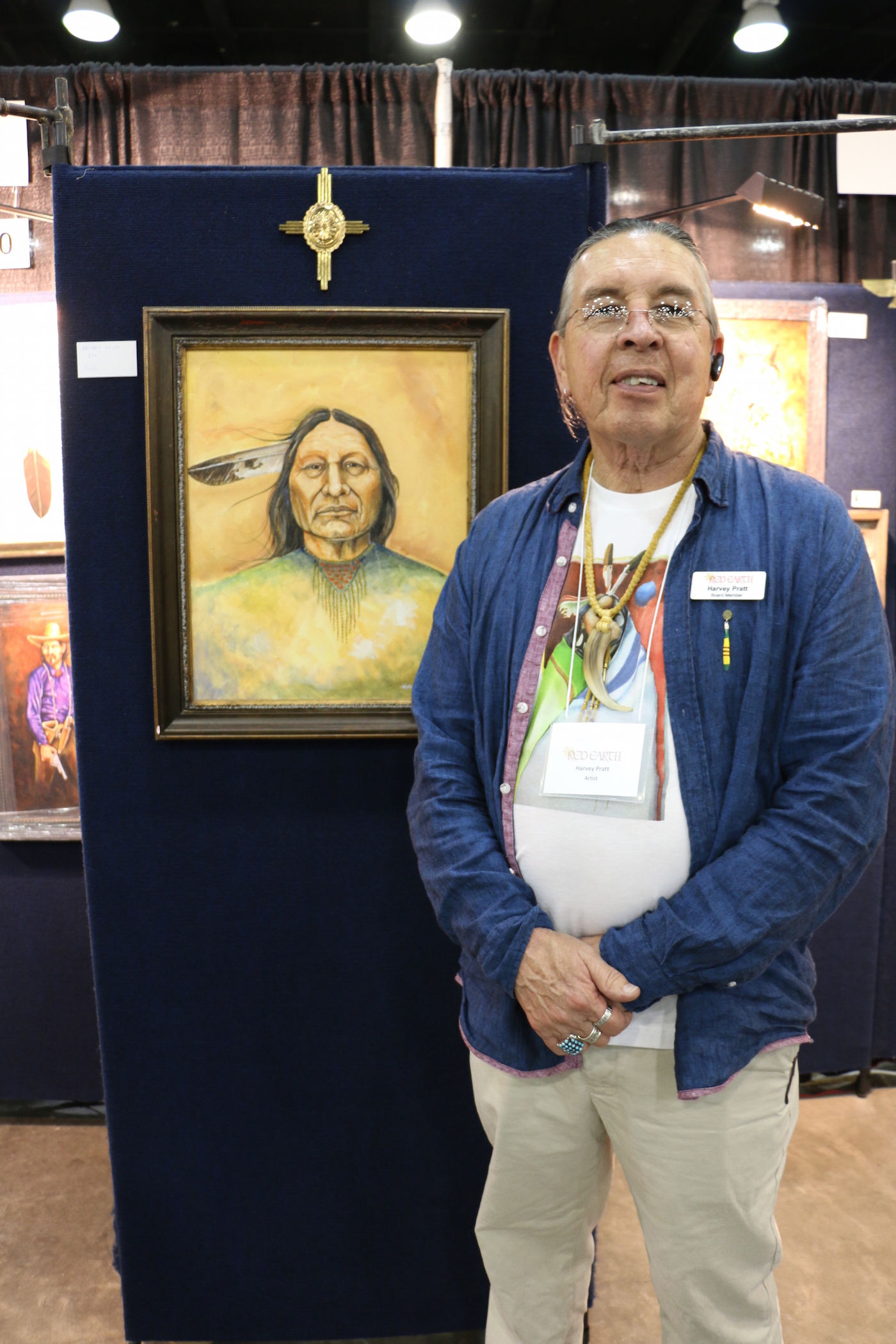
Cheyenne artist Harvey Pratt celebrates the new art at Red Earth while always remembering the past, posing near a reminder of what hooked him into the world of art, a painting of an Indian crucifixion. Photo by Cheyenne-Arapaho Tribal Tribune
Art and history come together at Red Earth
By Shaida Tabrizi
Cheyenne-Arapaho Tribal Tribune Reporter The drumbeat pounds life into the arena, enwrapping the dancers, the spectators and the artists in its cultural embrace through the sprawl of the 2015 Red Earth Festival where all have gathered to celebrate Native art. This year’s festival began as usual with a parade of elaborate floats from various Native tribes through downtown Oklahoma City and the Myriad Gardens. It then moved into the Cox Convention Center and out of the Oklahoma summer heat, to commence in earnest with its grand entry, dance competitions and dance offs, demonstrations of artistic techniques like hoop dancing and the opening of the art market. Over 150 artists displayed the fruits of their labors in booths sprawled out around the dance arena, selling works and explaining history to an internationally varied crowd. Many of the artists are busy throughout the year traveling to other shows or working the often unavoidable day job, so Red Earth also gives them a chance to catch up with old friends. For example, Cheyenne artist Harvey Pratt described the joy he feels in seeing the growing families of ones he has met at Red Earth and swapped stories with others about the early days of the festival. “I always enjoy coming to Red Earth. I’ve done all 29 years, since the very first one. I tell people the first year the Seminoles from Florida came in and they brought their own alligators and their own swimming pool and wrestled alligators! And they wouldn’t let them do it anymore,” Pratt said laughing. Pratt took time out of his busy schedule as a forensic artist for the Oklahoma State Bureau of Investigation where he uses his creative talent to help solve crimes. “But I always enjoy it here. I think the art is really excellent,” Pratt said. “There are a lot of really talented Native Americans.”

Red Earth’s 2015 Honored One award winner Merlin Little Thunder leafs through the small collection of sketches from the many artists at the festival debating what to draw himself. Photo by Cheyenne-Arapaho Tribal Tribune
The festival’s grand entry honored many from veterans to volunteers, to dancers and to artists. The chosen Honored One was Cheyenne artist Merlin Little Thunder, who walked proudly just behind the festival’s head dancers in the grand entry and then hurried back to his booth and his art. While signing and drawing in an autograph book from another artist, a yearbook of sorts for the 2015 festival since each artist sketches something small in their style next to their name, Little Thunder spoke highly of Red Earth. “This is a festival for all the people and all the Indian people to come together to showcase their talents, their art, their skills. It’s for all of us, it’s not just for those famous artists out there. It’s for the crafters. Whatever your talent or ability is, this is the time to come out here and showcase it,” Little Thunder said. “We’re a people that celebrate everything. We use this opportunity to show people we’re proud of our heritage.” Much of the artwork at Red Earth had deep historical and cultural meaning to the artists. A simple question on the type of paper used for a painting could easily turn into a mini-lecture on the impact of the past on the artistic creations of today.

Artists George Levi and Brent Learned display their historically rich work full of ledger art and depictions of traditional Cheyenne & Arapaho tribal stories. Photo by Cheyenne-Arapaho Tribal Tribune
Artists George Levi and Brent Learned showed their work together in a booth, happily explaining the significance of ledger art and describing their recent exhibition One November Morning: Art on Sand Creek by Cheyenne and Arapaho Artists. That exhibit featured their work as well as the contributions from three other tribal members descended from victims of the massacre, Little Thunder, B.J. Stepp and Cheyenne & Arapaho tribes Director of Economic Development Nathan Hart. Levi and Learned have traveled with the exhibit to Denver to give talks as well as contributing to documentaries about the Sand Creek Massacre. “That’s the first time that anyone can recollect where tribal members have gotten together to depict a massacre and telling their side of the story about that massacre,” Learned said. “That’s who we are. It’s a butterfly effect. You have to know where you came from in life to know where to go in life and you have to understand those things to know who you are.” Levi adamantly declared the importance of centering their art on the Cheyenne and Arapaho people. “We can tell our story and inform people about the origins of ledger art, inform them about our people,” Levi said. “Our art is just about us. So, we’re telling our own story our own way, and we don’t need to borrow anything. We’re just keeping it real Cheyenne and Arapaho.” Related Stories:
Red Earth Native American Cultural Festival ready for big kick-off (6/4)
Join the Conversation